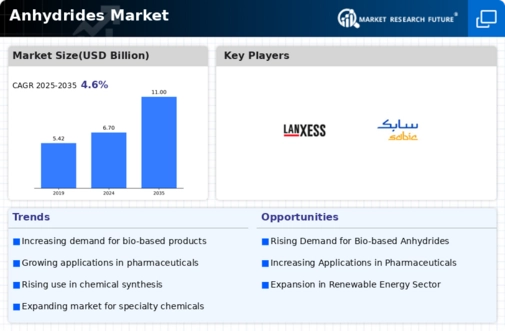Market Analysis
In-depth Analysis of Anhydrides Market Industry Landscape
The Anhydrides market displays a set of dynamic factors that influence its overall landscape, affecting supply, demand, and market conditions. A comprehensive understanding of these dynamics is crucial for businesses operating within this sector. Here's a concise overview in a paragraph format with key points highlighted:
Application Diversity: The dynamics of the Anhydrides market are heavily influenced by the diverse applications of anhydride compounds across various industries. From resins in the construction sector to plasticizers in the automotive industry, the demand for anhydrides is multifaceted. Market players must stay attuned to shifting application trends to align production with evolving market needs.
Global Economic Trends: The Anhydrides market is closely tied to global economic conditions. Economic fluctuations impact industries like construction, automotive, and electronics, directly affecting the demand for anhydride-based products. During economic downturns, reduced consumer spending and industrial activities can lead to a dip in demand, while periods of growth stimulate increased consumption.
Raw Material Costs: The production of anhydrides involves raw materials like acid anhydrides and alcohols. Fluctuations in the prices of these inputs can significantly impact production costs. Market players need to carefully manage their supply chains to navigate potential raw material challenges and adjust pricing strategies accordingly.
Regulatory Environment: The Anhydrides market dynamics are shaped by the regulatory landscape governing chemical manufacturing and usage. Compliance with safety, environmental, and quality standards is critical. Changes in regulations, especially those related to emissions and chemical safety, can influence production processes and market access. Staying abreast of regulatory developments is essential for market participants.
Technological Advancements: Ongoing technological advancements play a pivotal role in the Anhydrides market. Innovations in manufacturing processes, product formulations, and applications can create new opportunities and impact the competitive landscape. Companies investing in research and development to enhance efficiency, reduce environmental impact, and explore new applications gain a strategic advantage.
Environmental Sustainability: Growing awareness of environmental sustainability is influencing market dynamics. Anhydride manufacturers adopting eco-friendly practices and offering sustainable solutions gain favor in the market. The industry is witnessing a shift towards environmentally conscious alternatives, driven by both consumer preferences and regulatory pressures.
Competitive Landscape: The Anhydrides market is competitive, with numerous players vying for market share. Differentiation strategies, pricing policies, and innovation are key determinants of success. Companies must continually assess and adapt their strategies to navigate competitive pressures and maintain a strong market position.
International Trade Dynamics: The Anhydrides market is not confined by regional boundaries, and international trade dynamics significantly impact the industry. Changes in trade policies, tariffs, and geopolitical events can influence the import and export of anhydrides, affecting market competitiveness. Companies need to be aware of global trade dynamics to optimize their market position.













Leave a Comment